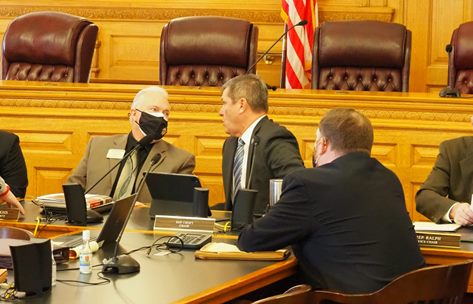Kansas nearly passed legislation last year that would have legalized cannabis for medical use. If it does so this year, it may be available by early 2024.
by Jim McLean, KCUR and Kansas News Service
Topeka, Kansas — State lawmakers find themselves on the verge of legalizing marijuana for medical use, but with stricter rules than the way cannabis has been cleared for use in other states.
The Kansas House passed a legalization bill last year. The Senate stood poised to start work on it in the opening weeks of the current session, but Republican Senate President Ty Masterson abruptly pulled the bill from the calendar.
Now the Senate Federal and State Affairs Committee has begun three days of hearings on the measure, a signal that the conservative Republicans controlling the Legislature have blessed tightly regulated legalization.
Masterson said he wasn’t opposed to legalization. Rather, he said, he wanted to make sure that bill was written tightly enough to guard against doctor-shopping and other tactics that allow people to get the drug on flimsy claims of medical need.
“There is some legitimate medical benefit to the derivatives of the cannabis plant,” Masterson said in a pre-session interview with the Kansas News Service. “The final hurdle is: What is a legitimate way to deliver it.”
Thirty-seven states have adopted medical marijuana programs. Recreational use is legal in 18 of them.
The Kansas legislation would allow doctors to recommend cannabis for chronic pain and the treatment of 22 specific diseases or conditions, including AIDS, cancer, multiple sclerosis, glaucoma, Parkinson’s disease and ulcerative colitis.
Patients suffering from other chronic or terminal conditions that a doctor believes would respond to cannabis could also be eligible.
Sam Jones, a Wichita lawyer, says the drug is a safer alternative to opioids and other prescription medications.
“The medical benefits are legitimate and verifiable,” he said.
They’re backed by studies that are growing in number as more states legalize medical cannabis.
Treatment options are limited by the bill. It prohibits smoking and vaping, allowing only edibles, oils, tinctures and patches.
Several people who testified in support of the bill urged lawmakers to remove the prohibition on smoking and vaping, including Jack Mitchell, the owner of a medical marijuana dispensary in Kansas City, Missouri.
He said states that started with similar restrictions have abandoned them.
The bill establishes a rigorous process for doctors who want the option of recommending cannabis to their patients.
Doctors would have to obtain certificates from the Kansas Board of Healing Arts to recommend medical marijuana to patients. They would also be required to submit annual reports detailing the drug’s effectiveness.
Patients and their designated caregivers would have to go through a doctor to obtain the drug. The physician would submit an application on their behalf to the Kansas Department of Health and Environment.
Patients approved to use the drug would get a secure identification card for a fee of $50. Veterans and low-income Kansans would pay only $25. Then they’d buy the drug at state-licensed cannabis dispensaries.
Disabled Army veteran Johnathan Lewis, from Missouri, told the Senate committee that medical marijuana lessens the chronic pain he suffers from injuries that required the amputation of one of his legs. And, he said, it helps him to be “an actual functioning member of society.”
Some supporters of the overall bill urged lawmakers to change provisions they said could lead to problems standing up a cannabis industry in Kansas.
Heather Hobbs Steppe, the president of the Kansas Cannabis Chamber of Commerce, said the high cost of licenses needed to cultivate, process and sell medical marijuana could limit its availability in rural areas.
“In order to have a successful program,” she said, “it’s going to have to … work in all four corners of the state.”
That, Steppe said, requires a program that “supports small businesses and family farmers.”
High licensing fees, she said, will drive up costs to consumers who might be forced to go back to the black market to obtain the drug.
The bill sets several milestones for establishing the rules and regulations needed to make the program operational.
If the measure passes and all those deadlines are met, medical marijuana would be available in Kansas by January 2024.
Jim McLean is the senior correspondent for the Kansas News Service. You can reach him on Twitter @jmcleanks or email jim (at) kcur (dot) org.
The Kansas News Service is a collaboration of KCUR, Kansas Public Radio, KMUW and High Plains Public Radio focused on health, the social determinants of health and their connection to public policy.
Kansas News Service stories and photos may be republished by news media at no cost with proper attribution and a link to ksnewsservice.org.
See more at https://www.kcur.org/news/2022-03-16/lawmakers-look-ready-to-legalize-medical-marijuana-but-likely-wont-let-kansans-vape-or-smoke-it.

